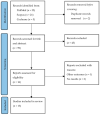Transcranial Direct Current Stimulation in the Treatment of Gait Disturbance in Post-Stroke Patients: An Overview of Systematic Reviews
- PMID: 38067673
- PMCID: PMC10708691
- DOI: 10.3390/s23239301
Transcranial Direct Current Stimulation in the Treatment of Gait Disturbance in Post-Stroke Patients: An Overview of Systematic Reviews
Abstract
Introduction: Transcranial direct current stimulation (tDCS) is a promising technique for brain modulation after a cerebrovascular accident (CVA). This treatment modality has been previously studied in the recovery of patients. The aim of this review is to analyse the evidence for the application of tDCS in the recovery of gait disturbance in stroke patients.
Methods: This review was conducted according to the recommendations of the PRISMA statement. Three different electronic databases were searched for relevant results: PubMed, Scopus, and Cochrane, from 2015 to January 2022. We included reviews and meta-analyses that only considered randomised controlled trials (RCTs) that investigated the effects of transcranial direct current stimulation, in combination or not with other physiotherapy treatments, compared to no treatment, usual care, or alternative treatment on gait recovery. Our primary outcomes of interest were walking speed, mobility, and endurance; secondary outcomes included motor function.
Results: Thirteen studies with a total of 195 RCTs were included. Data on population, outcome measures, protocols, and outcomes were extracted. The Amstar-2 scale and the GRADE system of certainty of evidence were used. Only one study received high certainty of evidence, 5 received low certainty of evidence, and 7 received critically low certainty of evidence. Moderate to low-quality evidence showed a beneficial effect of tDCS on gait parameters, but not significantly.
Conclusions: Although the tDCS produces positive changes in gait recovery in spatio-temporal parameters such as mobility, endurance, strength, and motor function, there is insufficient evidence to recommend this treatment. Higher-quality studies with larger sample sizes are needed for stronger conclusions.
Keywords: gait; neurorehabilitation; non-invasive stimulation techniques; physiotherapy; stroke; transcranial electrical stimulation.
Conflict of interest statement
The authors declare no conflict of interest.
Similar articles
-
Effects of cerebellar non-invasive brain stimulation on balance and gait performance in individuals with stroke: a systematic review and meta-analysis.Eur J Phys Rehabil Med. 2025 Apr;61(2):209-220. doi: 10.23736/S1973-9087.24.08692-1. Epub 2025 Mar 6. Eur J Phys Rehabil Med. 2025. PMID: 40047654
-
Noninvasive brain stimulation combined with other therapies improves gait speed after stroke: a systematic review and meta-analysis.Top Stroke Rehabil. 2019 Apr;26(3):201-213. doi: 10.1080/10749357.2019.1565696. Epub 2019 Feb 8. Top Stroke Rehabil. 2019. PMID: 30735104
-
Effects and safety of transcranial direct current stimulation on multiple health outcomes: an umbrella review of randomized clinical trials.Mol Psychiatry. 2024 Dec;29(12):3789-3801. doi: 10.1038/s41380-024-02624-3. Epub 2024 May 30. Mol Psychiatry. 2024. PMID: 38816583 Review.
-
Offline effects of transcranial direct current stimulation on reaction times of lower extremity movements in people after stroke: a pilot cross-over study.J Neuroeng Rehabil. 2019 Nov 7;16(1):136. doi: 10.1186/s12984-019-0604-y. J Neuroeng Rehabil. 2019. PMID: 31699109 Free PMC article.
-
Effectiveness of transcranial direct current stimulation on hand dexterity in stroke patients: a protocol for a systematic review and meta-analysis.BMJ Open. 2022 Feb 16;12(2):e056064. doi: 10.1136/bmjopen-2021-056064. BMJ Open. 2022. PMID: 35173006 Free PMC article.
Cited by
-
The Role of IL-6 and TNF-Alpha Biomarkers in Predicting Disability Outcomes in Acute Ischemic Stroke Patients.Life (Basel). 2025 Jan 2;15(1):47. doi: 10.3390/life15010047. Life (Basel). 2025. PMID: 39859987 Free PMC article.
References
-
- Winstein C.J., Stein J., Arena R., Bates B., Cherney L.R., Cramer S.C., Deruyter F., Eng J.J., Fisher B., Harvey R.L., et al. Guidelines for Adult Stroke Rehabilitation and Recovery: A Guideline for Healthcare Professionals from the American Heart Association/American Stroke Association. Stroke. 2016;47:e98–e169. doi: 10.1161/STR.0000000000000098. - DOI - PubMed
Publication types
MeSH terms
LinkOut - more resources
Full Text Sources
Medical


